Chinese Wedding Traditions: Customs, Engagement, Preparation, and Rites
A traditional Chinese wedding involves a series of customs and rites, including preparations, engagements, the wedding ceremony, and post-wedding celebrations.
The entire wedding culture, including the Three Letters and Six Etiquettes, was officially established during the Zhou Dynasty (1046 BC — 256 BC).
-
The Three Letters refer to formal documents used for engagement, betrothal gifts, and the wedding ceremony.
-
The Six Etiquettes include the proposal, inquiry, divination, presentation of betrothal gifts, determination of the wedding date, and the wedding ceremony.
While some details have been simplified or adapted over time, the core procedures have been well preserved.
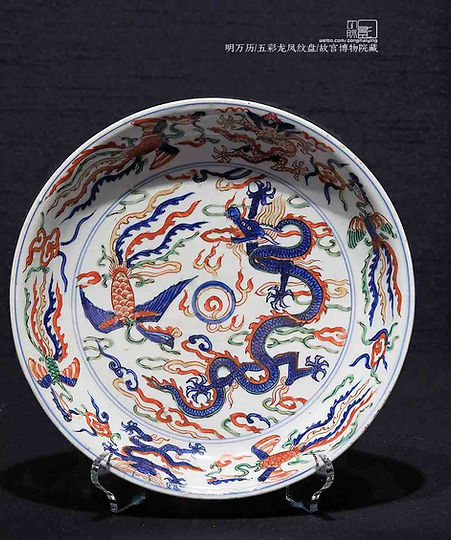
Porcelain Plate of the Ming Dynasty (1368 — 1644) with Dragon and Phoenix Images, Popular Patterns Used In Traditional Chinese Weddings — Palace Museum (Photo by Dongmaiying)
Chinese Matchmaking System: Historical Practices and Professional Matchmakers
Chinese Traditional Wedding Engagement Processes
Selecting an Auspicious Date for a Chinese Wedding
Customs and Traditions of Decorating the Wedding Bed
Chinese Wedding Attire: Timeless Elegance and Ritual
Chinese Wedding Ceremony: Auspicious Rites, Customs, and Meanings
The Ending Ceremony of A Chinese Wedding — Hui Men
Attire and Gifts: What to Wear and What to Give at a Chinese Wedding
Auspicious Words: Expressing Well-Wishes at Chinese Weddings


Traditional Chinese Wedding Outfits of Officials of the Ming Dynasty (1368 — 1644), by Xiefang Zhuren (Dong Jin)
Chinese Matchmaking and the Matchmaker System in History
Unlike today's free love, in ancient history, matchmaking was the most important way to bring about a marriage, arranged mainly by parents and matchmakers.
The resemblance of the couple's family background has been the key factor.
In ancient Chinese culture, the similarity of a couple's social status and family background was one of the essential considerations for marriage; this idea is still popular among some people nowadays.
Hence, professional matchmakers usually collect info about people of proper ages and resembling social status and their basic requirements for future spouses.

Mandarin Duck (Love Bird Yuanyang) Decorated Gold Pendant of the Ming Dynasty (1368 — 1644) — Sichuan Provincial Cultural Relics and Archeology Research Institute (Photo by Dongmaiying)
After finding a good match, the matchmaker would first talk with the man's parents.
If a person wanted to marry someone he/she already knew, he or she still needed to get the parents' approval first, and then find a matchmaker to propose to the beloved one's parents.
Nowadays, young people usually choose their partners on their own, which made this step gradually disappear.
However, couples that other people introduce would still express their gratitude for their matchmakers using gifts or money.

Fans Used in Traditional Wedding Ceremony, Photo from Yunduan Yinxiang.
Chinese Traditional Wedding Engagement Processes
Proposal and Agreement of Marriage
If the man's parents are happy with the matchmaker's suggestions, they prepare some gifts and ask the matchmaker to propose to the girl's parents.
After the girl's parents agree, they will provide certain information about the girl, including her name, birth date, and other required details, which the matchmaker will return to the man.
Then, they will take the new couples' names and birth dates to get divination and see if they are lucky to get married.
If the result were positive, they would inform the woman's parents that the marriage is officially settled and choose an auspicious date, usually through divination, for the engagement ceremony.
In every process, the matchmaker would bring ritual gifts; wild geese were the most ancient. Later, more valuable presents were added, based on one's family status and fortune.

Embraced Swan Geese Jade Pendant of Liao Dynasty (907 — 1125) — Inner Mongolia Institute of Cultural Relics and Archaeology (Photo by Dongmaiying)
Engagement and Betrothal Ceremony
On Engagement Day, the man’s parents would bring Betrothal Presents or Betrothal Money (Pin Li) to the woman’s parents.
The presents vary in historical eras, geographical places, social status, and financial situations; some common examples are tea, fabric, food, gold jewelry, etc.
Meanwhile, they also would bring two official documents, one regarding the announcement of the engagement (Betrothal Letter or Pin Shu) and another listing all of the betrothal gifts they brought (Gift Letter or Li Shu).
Some people also exchange their family trees to know each other better.
On the same day or a few days later, the woman’s parents would prepare some gifts in return to express kind gestures and goodwill for the new couple’s happy marriage.
This engagement rite is still widely implemented in China nowadays, with slightly different details.
Part of Common Betrothal Gifts (Pin Li) of Rich Families of the Song Dynasty (960 — 1279)

Gold Rings
Capital Museum

Gold Bangles
Capital Museum
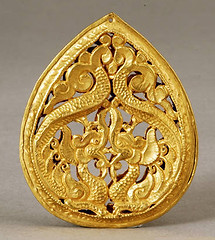
Gold Pendant of Robe
Anhui Museum
How to Choose Auspicious Dates for Chinese Weddings
After the engagement day, the new couple's parents would choose a lucky date through divination to hold the wedding ceremony based on the new couple's birth dates and Zodiac Signs.
In traditional Chinese culture, March, June, July, and November of the Chinese Calendar were not good for getting married.
June implies half and incomplete, July is the month of ghosts (because the Ghost Festival is on the 15th of July), and March and November have unlucky homophonic meanings as "separation" and "unfulfilled."
Today, many Chinese couples still choose their wedding date through divination.
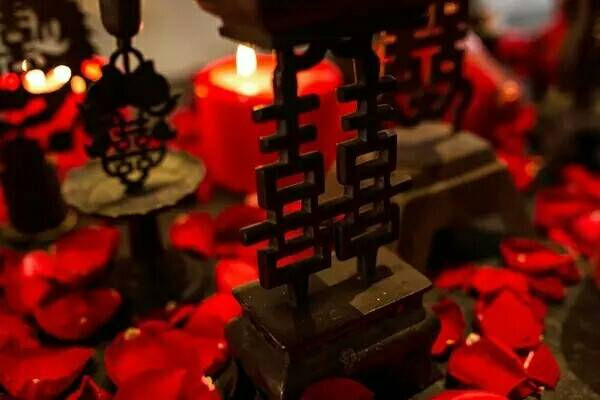
Hanzi "Xi" (Double Happiness Symbol), Using of it is the Representative of Chinese Wedding.
Wedding Bed Decorations
Arranging the new couple's bed or Anchuang is one of the most important parts in Chinese wedding traditions.
Some days before the wedding ceremony, the new couple's bed should be set up and decorated with brand-new red bedclothes.
Meanwhile, dates, peanuts, longan, and lotus seeds would be scattered on the new bed, symbolizing happiness, fortune, and the wish for many children in Chinese culture.
People who arrange the new bed are chosen based on their "lucky fates": those who have healthy parents, many siblings, a happy marriage, and many children (now it is not this strict).
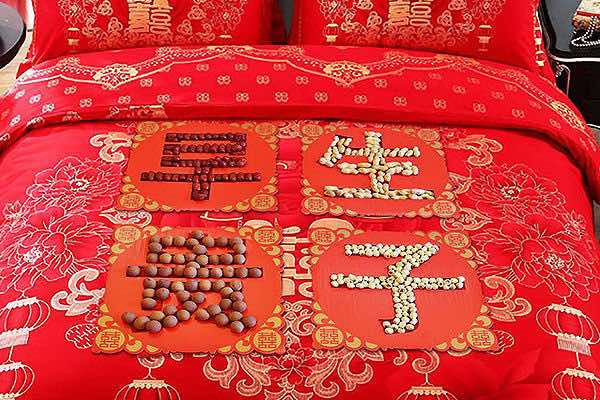
Traditional Chinese Wedding Bed Decorated with Red Dates, Peanuts, Longans, and Lotus Seeds.
After the wedding bed is set up, usually not allow other people to sit or sleep on it, especially pregnant women and people in the mourning period.
In some places, toddlers can play on the bed for a while before the wedding date.
Besides the bed, the new couple's bedroom and halls for their wedding ceremony will also be decorated, primarily red, with auspicious decorations.
Click to Read Chinese Color Symbolism, Auspicious Flowers and Meaning, and Chinese Patterns.

Traditional Wedding Ceremony Hall, Photo from Duke Landao.
Chinese Wedding Dress: Timeless Elegance and Ritual
Chinese wedding dress includes all attires from historical dynasties, following strict hierarchy regulations in ancient history.
Today, people can choose whichever style they like and change several times as they want to, from Western-style bridal gowns to modern-designed cheongsam and traditional outfits from history.
Generally, however, the groom and bride's outfits would match each other; for instance, from the same dynasty and the same hierarchy for those wearing traditional clothes.
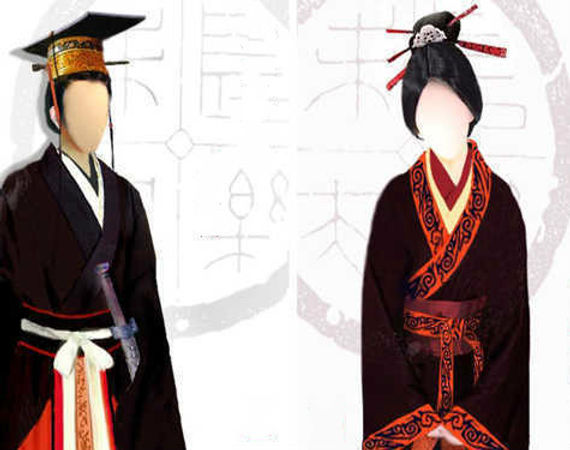
Wedding Costumes of the Zhou Dynasty (1046 BC — 256 BC)

Wedding Costumes of the Tang Dynasty (618 — 907)

Wedding Costumes of the Ming Dynasty (1368 — 1644), by Xiefang Zhuren (Dong Jin)
Chinese Wedding Ceremony: Auspicious Rites, Traditions, Customs, and Meanings
Sending the Dowry
Before the wedding day, today some people do it on the wedding day, the bride’s parents send dowries to the groom (this varies in different historical stages, geography, social status, and financial situations).
The dowry is an essential representative of the bride’s family background, social status, and how much her parents cared about her well-being.

Jade Chinese Cabbage, One of Dowries of Princess Jin, the Imperial Concubine of the Emperor Guangxu (1875 — 1908) — Taipei Palace Museum
Combing Hair Ritual
One day before or on the big day, the new couple would have their hair combed by a lucky elder with healthy parents, siblings, a good marriage, and many children (now it is not that strict).
In this ritual, the chosen lucky people would use a new comb to comb their hair four times, representing longevity, loyalty, many children, and good luck.
Setting Off of the Groom's Team
Then, the groom would inform his ancestors and parents that he would welcome his beautiful bride with a bridal sedan chair, now with cars.
With his best men group, relatives, and good friends, he will set off to the bride's place to take her home.
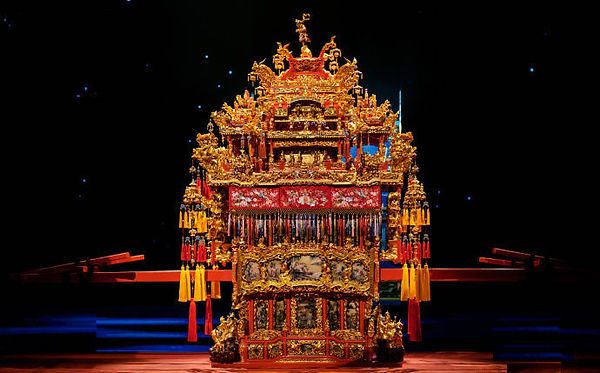
Exquisite Bridal Sedan Chair of the late Qing Dynasty (1636 — 1912) — Zhejiang Museum
The Bride and Her Family's Tears on the Wedding Day
After the groom had arrived and met with his beautiful bride, they would bid farewell to the bride’s parents when the bride usually would cry sadly.
In old times when parents arranged marriage, many brides might have never met their grooms.
Moreover, the transportation was not as convenient as today; if someone married far away, she probably would never go back and see her parents again. So it was natural for brides to weep on their wedding day.
Nowadays, people get married freely to the one they choose on their own, and they can go back and visit their parents whenever they want; however, many brides and their parents still cry on the wedding day before they leave the family.

Rites to Welcome the Bride Home via a Different Route
When the new couple leaves the bride's home, and before they walk into the groom's place, people sprinkle rice into the sky in front of them, meaning their new life together would be happy, prosperous, and with many children.
Nowadays, petals and colorful, shining paper are more frequently used.
Afterward, the groom would take his bride back to his parents.
Importantly, they would use another route different from the one where the groom came to take the bride; this means this marriage is irreversible.
Nowadays, many people still strictly follow this rule in Chinese wedding ceremonies.

Ancient Candlesticks for Chinese Traditional Wedding
Declaration Rites in Traditional Chinese Wedding
After the new couple had arrived at the groom’s family, the most important ritual of a traditional Chinese wedding would be held.
Together, they would declare their dignified marriage.
-
Firstly, bow to heaven and earth to worship and inform the whole universe and surroundings about their marriage.
-
Secondly, bow to parents, showing respect and gratitude for raising the groom.
-
Thirdly, bow to each other, meaning that they would trust the rest of their lives with their future spouse from then on.
This shows the essential commitment of marriage.
Afterward, they are officially married.
Today, if a couple chooses to hold a traditional Chinese wedding, the Three Bow Ceremony is still one of the most important rites they would follow.
Silver Belt Hook Carved with "Infinite Happiness, Unforgettable Love", Unearthed from Tomb of King Liu Fei (168 BC — 128 BC) — Nanjing Museum
Chinese Wedding Tea Ceremony — Significance and Traditions
The Tea Ceremony has been an essential wedding ritual from ancient times.
Tea trees can only grow from seeds and cannot be transplanted, representing unchanging love and eternal loyalty.
The traditional Chinese Wedding Tea Ceremony usually is simple; the new couple serves tea to their parents to show their gratitude for making this marriage happen, is willing to support and take care of each other, and is a symbol of officially becoming a family.
The timing of a tea ceremony at a Chinese wedding differs, some serve the bride's parents before the groom takes back the bride and then serve the groom's parents after the whole wedding ceremony, and some serve all parents during the official rites.
To sum up, flexible timing, with eternal respect and gratitude.

Part of Wedding Porcelain Sets for Emperor Tongzhi (1862 — 1874) — Palace Museum
Bonding Rites in Traditional Chinese Weddings: Symbolizing Unity and Harmony
Finally, the new couple would be sent to their room and sit on the newly arranged bed.
Historically, both bride and groom would cut off a strand of their hair, put and tie them together, and save it properly.
Since hair has been considered an essential part of the body in ancient Chinese culture, binding their hair together means the new couple would become a whole from now on. This ceremony is now mostly abolished.
The Rite of drinking cross-cupped wine, however, has been inherited as a means of expressing intimacy.
Some other rites differed among geographical places; throughout history, however, a big wedding reception after the ceremony has been an important, necessary tradition.

Unearthed Bronze Bind-Cups (He Jin Bei) of the Han Dynasty (202 BC — 220 AD) that used for A Couple to Drink Cross-Cupped Wine on Their Wedding — Institute of Archaeology, Chinese Academy of Social Sciences
The Ending Ceremony of a Chinese Wedding: Hui Men
The Hui Men Ceremony is usually held on the next or the third day after the wedding ceremony.
During this ceremony, the new couple returns to the bride’s parents’ place with an even number of gifts to assure them of her safety and well-being or to share some details about her new husband.
In old times, this may be the last time for the bride to see her parents (if they lived far away), so it was a significant rite.
The new couple usually would worship the bride’s ancestors, bow and serve tea to her parents, and have dinner with them.
Generally, they would leave before sunset.
After this Hui Men ceremony, the whole wedding is considered completed successfully.
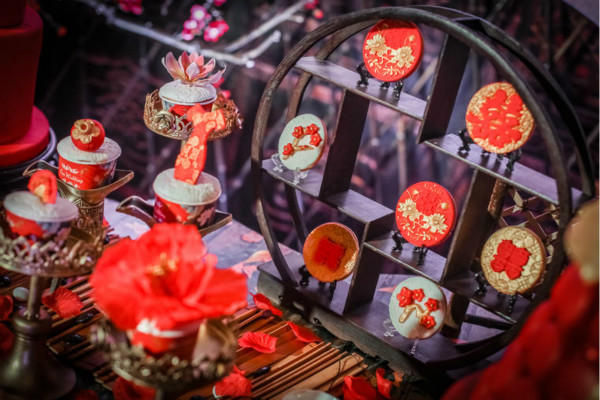
Auspicious Decorations of Traditional Wedding, Photo from Yijiangnan.
Attire and Gifts: What to Wear and What to Give at a Chinese Wedding
Attire for Attending a Chinese Wedding Reception
To attend today's weddings, guests usually don't have stringent requirements unless the new couple has informed dress codes in advance. Warm color clothes are highly recommended.
But red and white clothes are impolite to wear to a wedding since those two are the colors the bride would wear — red for traditional dresses and white for western-style wedding gowns.
Traditional Gifts for Newlyweds
Money in a red envelope is the most common gift for Chinese weddings today, which the new couple can use to buy whatever they want.
The number amount depends on one's closeness to the new couple, usually auspicious integer numbers.
A decent gift is also an option, usually from very close friends or family who know this is the gift that the bride or groom wanted, and it is not cheap.
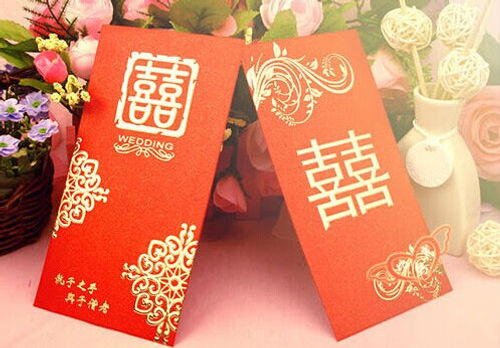
Red Envelopes with Money Inside, the Commonest Gift in Chinese Weddings.
Expressing Well-Wishes at Chinese Weddings
Besides congratulations, there are some ancient idioms and poems with beautiful meanings to say or write to a newly wedding couple, to express one's sincere greeting, and to praise their sweet love.
花好月圆: Blooming flowers and a full moon, represent beautifulness and perfection.
佳偶天成: Perfect match like is arranged by divines.
珠联璧合: The gathering of pearls and jade, represents beautiful and happy couples.
共度爱河: Live in the river of love, meaning the combination of a loving couple.
天作之合: Perfect couple arranged by heaven.
凤凰于飞: Phoenixes flying in the sky, representing harmonious conjugal love.

Phoenix Shape Golden Decorations of the Ming Dynasty (1368 — 1644) — Changzhou Museum (Photo by Dongmaiying)
举案齐眉: Couple of mutual respect and love.
百年好合: Lifetime of conjugal felicity.
同心同德: Alike heart, faith, and goal.
白头偕老: Live happily together until hair turns grey.
比翼双飞: Love birds Biyi flying in the sky, representing a blessed couple supporting each other in life and careers.
天长地久: Eternal as heaven and earth.
Click to Read More Chinese Symbols, Phrases, Characters, and Poems about Love
You Might Also Like:
Chinese Fan — History, Classification, Utilization, Art, Culture, and Artifact
Chinese Surnames — Eight Ancient Chinese Surnames and Their Evolvements
Chinese Names — Structure, History, Key Factors, Taboos, and Classic Examples
Chinese Zodiac Signs — A Comprehensive Introduction
Chinese Astrology — Three Enclosures, Four Symbols, Twenty-eight Lunar Mansions
Chinese Costume and the Strict Hierarchy in the History
Daily Etiquette in the Tradition of China
Hello in Chinese — Chinese Greetings in Daily Life and in Written Letters
Chinese Wine Culture and Table Manners








